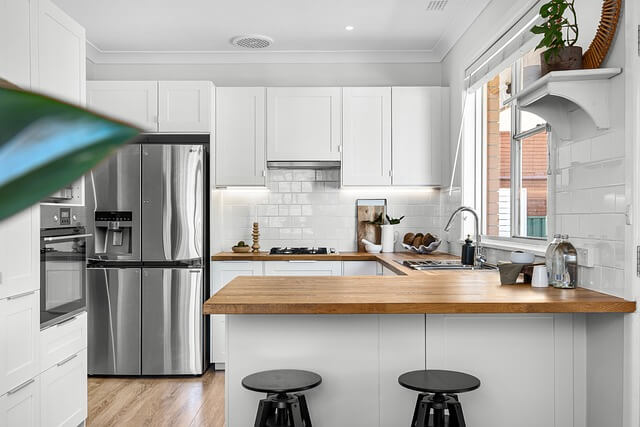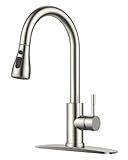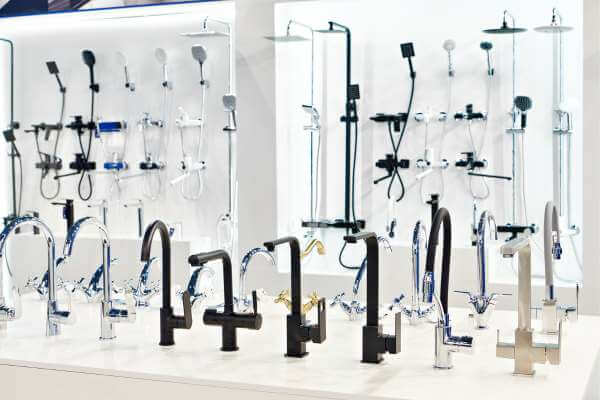When it comes to kitchen and bathroom renovations, the faucet is often an afterthought. However, a good faucet can make a big difference in the overall look and functionality of your space. With so many options available, it can be overwhelming to decide how much to spend on a faucet. As someone who has gone through the process of renovating my own kitchen and bathroom, I can tell you that determining a budget for a faucet is an important step in the planning process.
After doing some research and speaking with professionals, I found that the cost of a faucet can vary greatly depending on factors such as the brand, style, and materials used. According to a guide from Dwell, a basic kitchen faucet can cost around $150 to $300, while mid-range options with more style choices can start around $500 and climb to $1,000. At the top end, prices can creep toward thousands of dollars, although $1,500 is a good ballpark. However, it’s important to keep in mind that price doesn’t necessarily equate to quality.
Determining Your Budget
Understanding Your Financial Situation
Before deciding on how much to spend on a faucet, it’s important to understand your financial situation. Take a look at your income, expenses, and savings to determine how much you can afford to spend on home improvements.
Consider creating a budget to help you allocate your funds. This will help you keep track of your expenses and ensure that you don’t overspend. You can use budgeting tools like the NerdWallet Budget Calculator to help you get started.
Allocating Home Improvement Expenses
When it comes to home improvement expenses, it’s important to allocate your funds wisely. Consider the overall value of your home, the cost of the project, and the potential return on investment.
According to Dwell, a kitchen faucet can cost anywhere from $150 to thousands of dollars. Mid-range options start around $500 and climb to $1,000. Keep in mind that you’re paying for extra features or style rather than basic reliability or durability when you spend more.
For a bathroom faucet, The Family Handyman suggests spending at least $65 for a bath faucet and at least $100 for a kitchen faucet. Spending much more means you’re paying for extra features or style rather than basic reliability or durability.
Consider your personal preferences and how long you plan to stay in your home when deciding on how much to spend on a faucet. If you’re planning on staying in your home for a while, it may be worth investing in a higher-priced faucet that will last longer and provide added convenience.

Understanding Faucet Types and Prices
When it comes to purchasing a faucet, there are a few things to consider, including the type of faucet and its price. In this section, I will break down the different types of faucets and their price ranges.
Bathroom Faucets
Bathroom faucets are typically less expensive than kitchen faucets and can range from around $50 to $500. The price largely depends on the type and design of the faucet. For example, a basic single-handle faucet will be less expensive than a widespread faucet with intricate details.
Some popular types of bathroom faucets include:
- Centerset: These faucets have two handles and a spout mounted on a base plate.
- Widespread: These faucets have three separate pieces: two handles and the spout. The standard distance between the handles is at least 8 inches.
- Single-handle: These faucets have one handle that controls both the temperature and water flow.
Kitchen Faucets
Kitchen faucets are usually more expensive than bathroom faucets and can range from around $100 to $1,500. The price depends on the type of faucet, the materials used, and the features offered. For example, a basic pull-out spray faucet will be less expensive than a touchless faucet with a built-in water filtration system.
Some popular types of kitchen faucets include:
- Pull-out spray: These faucets have a detachable spray head that can be pulled out from the spout.
- Pull-down spray: These faucets have a spray head that pulls down directly into the sink.
- Touchless: These faucets use motion sensors to turn the water on and off, making them more hygienic.
Utility and Outdoor Faucets
Utility and outdoor faucets are typically the least expensive of all faucet types and can range from around $10 to $100. These faucets are designed for practicality rather than style and are usually made of durable materials like brass and stainless steel.
Some popular types of utility and outdoor faucets include:
- Wall-mounted: These faucets are mounted directly onto the wall and are commonly used for outdoor spigots.
- Laundry: These faucets are designed for use in laundry rooms and are usually made of chrome or brass.
- Hose bib: These faucets are used for outdoor hoses and can be either frost-free or non-frost-free.
Overall, the price of a faucet largely depends on the type and design of the faucet. It is important to consider your needs and budget when choosing a faucet for your home.
Factors Influencing Faucet Prices
When it comes to purchasing a faucet, there are several factors that influence its price. Understanding these factors can help you make an informed decision when choosing a faucet for your home. In this section, I will discuss the three main factors that influence faucet prices: Material and Finish, Brand and Quality, and Features and Technology.
Material and Finish
The material and finish of a faucet can greatly impact its price. Faucets made from high-quality materials, such as brass or stainless steel, tend to be more expensive than those made from cheaper materials like plastic or zinc. Additionally, the finish of the faucet can also affect its price. Chrome and brushed nickel finishes are generally less expensive, while finishes like oil-rubbed bronze or matte black can be more expensive.
Brand and Quality
The brand and quality of the faucet can also play a significant role in its price. Well-known brands with a reputation for quality and durability, such as Delta or Kohler, tend to be more expensive than lesser-known brands. Additionally, faucets with higher quality components, such as ceramic disc valves, will generally be more expensive than those with cheaper components.
Features and Technology
Finally, the features and technology of a faucet can also impact its price. Basic faucets with no additional features will be less expensive than those with added features like a pull-down sprayer or touchless technology. Smart faucets with features like voice-activated controls or water usage monitoring will also be more expensive than basic faucets.
In summary, when it comes to faucet prices, the material and finish, brand and quality, and features and technology all play a role. By understanding these factors, you can make an informed decision when choosing a faucet that fits your budget and meets your needs.
Cost of Faucet Installation
When it comes to installing a new faucet, the cost can vary depending on a few factors. In general, the cost of a faucet installation can range from as low as $50 for a basic DIY installation to over $4,600 for a more complex project. In this section, I will discuss the cost of faucet installation and the different options available.
DIY Installation
If you’re handy and have experience with plumbing, you may be able to install a faucet yourself. The cost of a DIY installation can be as low as $50 for a basic installation. However, keep in mind that if you make a mistake during the installation, it could end up costing you more in the long run. Additionally, if you’re not experienced with plumbing, it’s best to leave the installation to a professional.
Professional Installation
If you’re not comfortable with a DIY installation, you can hire a professional plumber or handyman to install your faucet for you. The cost of a professional installation can vary depending on the complexity of the project and the hourly rate of the plumber or handyman. On average, the cost of a professional installation can range from $161 to $363, with an average cost of $260.
When it comes to hiring a professional, it’s important to choose a reputable plumber or handyman. You can check online reviews and ask for references to ensure you’re hiring someone who will do a good job. Additionally, some hardware stores offer installation services, so you may want to check with your local store to see if they offer this service.
In conclusion, the cost of a faucet installation can vary depending on whether you choose to do it yourself or hire a professional. While a DIY installation may save you money, it’s important to have experience with plumbing to avoid costly mistakes. Hiring a professional can ensure a proper installation, but it comes at a higher cost.
Long-Term Considerations
When buying a faucet, it’s important to consider not only the upfront cost but also the long-term expenses. In this section, I’ll discuss some of the long-term considerations you should keep in mind.
Maintenance Costs
One important factor to consider is the maintenance cost of the faucet. Some faucets require more maintenance than others, which can add to the overall cost of owning the faucet. For example, if you choose a faucet with a lot of intricate parts, you may need to pay for more frequent repairs or replacements. On the other hand, if you choose a faucet that is easy to clean and maintain, you may be able to save money in the long run.
Replacement
Another long-term consideration is the cost of replacing the faucet. Even the best-made faucets will eventually wear out and need to be replaced. When choosing a faucet, it’s important to consider the cost and availability of replacement parts. If you choose a faucet that is no longer being manufactured, you may have difficulty finding replacement parts when you need them. This can add to the overall cost of owning the faucet.
Warranty
Finally, it’s important to consider the warranty when choosing a faucet. A good warranty can provide peace of mind and save you money in the long run. Look for a warranty that covers both parts and labor, and make sure you understand the terms and conditions of the warranty before making your purchase. Keep in mind that some warranties may be voided if the faucet is not installed by a licensed professional, so be sure to read the fine print.
In summary, when choosing a faucet and deciding How Much Should You Spend on a Faucet, it’s important to consider not only the upfront cost but also the long-term expenses. Take into account the maintenance costs, the cost of replacement, and the warranty to make an informed decision that will save you money in the long run.
Conclusion
After researching various sources on How Much Should You Spend on a Faucet, I have found that the amount you should spend on a kitchen faucet depends on your needs and budget.
If you are looking for a basic faucet that gets the job done, you can find options for as little as $50. However, it is important to note that these faucets may not be as durable or reliable as more expensive models.
For those who want a faucet with more features or style choices, mid-range options start around $500 and can climb up to $1,000. At this price point, you can find faucets with pull-down sprayers, touchless technology, and various finishes to match your kitchen decor.
If budget is not a concern, high-end faucets can cost several thousand dollars. These faucets often include advanced features like voice-activated controls, water filtration systems, and customizable settings.
Ultimately, the decision on how much to spend on a kitchen faucet comes down to your personal preferences and needs. Consider factors such as durability, style, and functionality when making your purchase. With the right faucet, you can elevate the look and functionality of your kitchen for years to come.
Frequently Asked Questions
What are the factors that determine the cost of a faucet?
The cost of a faucet depends on various factors, including the brand, the material used, the design, and the features it offers. Faucets made of high-quality materials such as brass or stainless steel tend to cost more than those made of plastic or low-quality metals. Moreover, faucets with advanced features such as touchless sensors or pull-out sprayers are more expensive than basic models.
Is it worth investing in a high-end faucet?
Investing in a high-end faucet can be worth it if you’re looking for a durable, reliable, and stylish product that can last for years. High-end faucets often come with advanced features, such as ceramic disc valves, which ensure smooth and drip-free operation. Additionally, they are typically made of high-quality materials that can withstand wear and tear.
What is the average lifespan of a faucet?
The average lifespan of a faucet depends on several factors, such as the quality of the product, the frequency of use, and the level of maintenance. Generally, a high-quality faucet can last for 15-20 years or more if it’s properly installed and maintained. However, low-quality faucets may only last for a few years before they start to leak or malfunction.
Can a low-priced faucet still be of good quality?
Yes, a low-priced faucet can still be of good quality if it’s made of durable materials and has a simple design. However, it’s important to note that low-priced faucets may not have advanced features such as ceramic disc valves or touchless sensors, which can affect their performance and durability.
Are there any cost-effective ways to upgrade a faucet?
Yes, there are several cost-effective ways to upgrade a faucet without replacing it entirely. For example, you can replace the aerator, which can improve water flow and reduce splashing. Additionally, you can replace the handles or spout, which can give your faucet a fresh new look without breaking the bank.
How do I know if I’m getting a fair price for a faucet installation?
To ensure that you’re getting a fair price for a faucet installation, it’s important to get quotes from multiple contractors and compare their prices and services. Additionally, you can research the average cost of faucet installations in your area to get an idea of what to expect. However, keep in mind that the cheapest option may not always be the best, as low-priced contractors may cut corners or use low-quality materials.












 Hi, my name is Debra Klein and I love modern kitchen designs! As a product reviewer, it’s my mission to help homeowners choose the right modern kitchen accessories for their homes. I want to give them the best solution possible so they can make the best decision for their needs. Thanks for reading!
Hi, my name is Debra Klein and I love modern kitchen designs! As a product reviewer, it’s my mission to help homeowners choose the right modern kitchen accessories for their homes. I want to give them the best solution possible so they can make the best decision for their needs. Thanks for reading!




